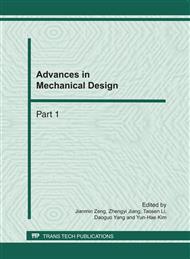p.308
p.313
p.318
p.323
p.329
p.337
p.341
p.348
p.354
Study on Minimum Teeth without Undercutting of Standard Involute Gears
Abstract:
In textbooks of mechanical engineering, rack has been mistakenly regarded as rack cutter so that minimum teeth without undercutting have been deduced, which has made people misunderstand undercut phenomenon more than 65 years. Theoretical research and computer simulation about undercut phenomenon are presented in this paper. Firstly, the theoretical analysis and calculation on minimum teeth without undercutting have been carried out, the rack cutter is used to infer minimum teeth without undercutting of standard involute gears, and correct minimum teeth without undercutting are get; And then computer simulation is applied to verify validity results of theoretical calculations, which not only corrects the long-standing mistakes about the traditional undercut phenomenon, but also provides the correct theoretical guidance for gears’ manufacturing.
Info:
Periodical:
Pages:
329-336
Citation:
Online since:
February 2011
Authors:
Price:
Сopyright:
© 2011 Trans Tech Publications Ltd. All Rights Reserved
Share:
Citation:


